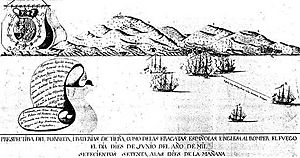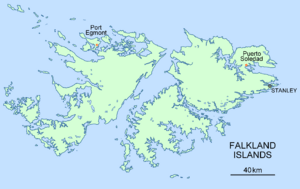Capture of Port Egmont facts for kids

Spanish engraving of the capture of Port Egmont in 1770
|
|
| Date | 10 June 1770 |
|---|---|
| Location | Port Egmont, Saunders Island, Falkland Islands |
| Participants | |
| Outcome | Spanish occupation Beginning of the Falklands Crisis. |
| Deaths | none |
The Capture of Port Egmont happened on June 10, 1770. It was when Spain took over the British fort at Port Egmont on the Falkland Islands. This fort had been used by the British since 1765. This event almost caused a war between Great Britain and Spain. This near-war is known as the Falklands Crisis.
Spanish leaders in Buenos Aires knew about the British settlement. They started telling the British to leave Spanish land. The British also told the Spanish to leave their land.
The British refused to leave. So, Spain sent a large force. About 1,400 Spanish soldiers on five ships sailed from Buenos Aires. Their mission was to force the British out of West Falkland. The small British group could not fight such a large force. After firing their guns a few times, they gave up. They were allowed to return to their country on their ship, the Favourite.
Contents
Why Port Egmont Was Captured
Spain knew the British were on the Falkland Islands. This was even before Spain took over the French colony at Port Louis. Spain renamed it Puerto Soledad in January 1767.
Early Warnings and Claims
On November 28, 1769, Captain Anthony Hunt was in charge of the British fort on Saunders Island. He saw a Spanish ship sailing around the island. It looked like it was checking things out. Captain Hunt sent a message telling the Spanish commander to leave.
Letters went back and forth between them. Each side said the islands belonged to their country. They both demanded the other side leave. Captain Hunt clearly stated that the Falkland Islands belonged to Britain. He demanded that the Spanish ships depart.
Spain Takes Over Port Egmont
Francisco Bucareli, the governor of Buenos Aires, sent ships to kick out the British. General Juan Ignacio de Madariaga led these ships. They included the frigates Industria, Santa Bárbara, Santa Catalina, and Santa Rosa. There was also a ship called the Andaluz. It carried 1,400 soldiers and heavy weapons.
This large Spanish force surprised the British at Port Egmont. The British had built a wooden fort and had eight cannons. But they were no match for the Spanish army.
The British Surrender
The Spanish soldiers came ashore. After a short exchange of gunfire, the British commanders gave up. Commander William Maltby and Commander George Farmer asked for terms to surrender. They and other settlers were held for 20 days. Then, they were allowed to sail back to England. They used their only remaining ship, the 16-gun Favourite. Another British ship, the Swift, had sunk earlier.
The new Spanish occupiers renamed the town Cruzada. They took control of everything. When this news reached Britain, people were very angry.
What Happened Next
News of the British being forced out caused a big stir in Britain. The British government was furious. They saw it as a terrible act. This event almost started a war with Spain.
Britain Demands Action
Lord Weymouth, a top British official, sent a message to Spain. He demanded that the British settlers be returned to Port Egmont right away. He also demanded an apology for insulting the British crown.
At first, Spain gave unclear answers. They tried to change the topic to who owned the islands. But Lord Weymouth refused to discuss anything else. He insisted on the return of the settlers and an apology first. Britain started getting ready for war very quickly.
Peace is Found
Both sides felt pressure to go to war. But good sense won out. France, who was Spain's ally, refused to support Spain in this problem. So, Spain had to back down.
Spain claimed that the takeover was done without their king's permission. King Charles III had not ordered it. Spain offered to give Port Egmont back exactly as it was before it was captured. The Spanish ambassador in London, Prince de Maserano, said that the governor of Buenos Aires had no special orders. However, the governor had acted according to his general instructions. He had also followed the laws of the Indies, which said to remove foreigners from Spanish lands.
The ambassador offered to return the British to Port Egmont. But Spain would not give up its claim to the Falkland Islands. In return, Spain asked Britain to say that Captain Hunt was wrong. Captain Hunt had told the Spanish to leave Soledad, which Spain said led to their actions.
Agreement and Return
An agreement was finally reached on September 15, 1771. This was six months after the British were forced out. The agreement put things back to how they were before Port Egmont was captured. By April, a British warship, the 32-gun HMS Juno, arrived. Captain John Stott was in command. Two other ships, the Hound and the Florida, came with it. They were there to bring back British rule.
The quick agreement was important. Spain's actions at Port Egmont made other countries in Europe fear war. Britain had a much stronger military. So, Spain was very willing to find a quick and friendly solution with Britain.
British Withdrawal and Later Claims
The British left the islands in 1774. This was part of a plan to save money. But they left behind a flag and a plaque. These showed that Britain still claimed ownership.
Later, in 1829, a British official explained this. He said that Britain leaving the islands in 1774 did not mean they gave up their rights. It was just a way to save money at the time. But signs of ownership were left on the islands. When the governor left, the British flag was still flying. All the proper steps were taken to show ownership. This also showed that Britain planned to return later.
Spain took over Port Egmont again during the Anglo-Spanish War (1779-1783). But Spain slowly lost control of its colonies. Spanish troops stayed at Port Louis, then called Port Soledad, until 1806. Governor Juan Crisóstomo Martínez left then. He left a plaque claiming the islands for Spain. The remaining Spanish settlers were removed in 1811. This was ordered by the Spanish Governor in Montevideo.
See also
 In Spanish: Combate de Puerto Egmont para niños
In Spanish: Combate de Puerto Egmont para niños


